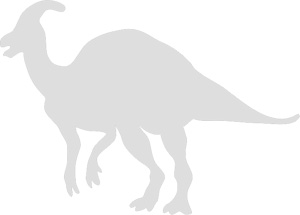Coahuilasaurus lipani
Every month, 100,000 readers use the Dinosaur Database, but we receive no support from you. Developing and updating the database requires a lot of work. If you want it to remain open and be updated, please support us via the "Buy us a coffee" button available on every page or via the Support page.
Dinosaur: Coahuilasaurus lipani

| Length*: | 9.6 m | 31.5 ft |
| Weight*: | 5 t | 11,023 lb |
*The largest known specimen
Period
Epoch: Late Cretaceous
Stage: Late Campanian
Years: 83.6–72.1 Ma
Details
Status: valid
Author: Longrich et al.
Year: 2024
Distribution
Area: North America
Country: Mexico
Region: Coahuila
Formation: Cerro del Pueblo
Description
Coahuilasaurus lipani
Coahuilasaurus lipani is a newly described kritosaurin hadrosaurid from the Late Cretaceous period (Late Campanian, around 72.5 million years ago) discovered in the Cerro del Pueblo Formation in Coahuila, Mexico. The name “Coahuilasaurus” references the Coahuila State in Mexico, where the fossils were found, and “lipani” honors the Lipan Apache tribe of the region. This species adds to the known diversity of hadrosaurids in southern Laramidia during the Late Cretaceous.
Physical Characteristics
Coahuilasaurus lipani is known primarily from a partial skull (holotype IGM 6685) that includes the premaxillae, parts of the maxillae, vomer, pterygoid fragment, predentary, and anterior ends of the dentaries. The skull bones are articulated and preserved in a sandstone matrix with shells of gastropods and bivalves. The preserved bones suggest that Coahuilasaurus was a large hadrosaurid, with an estimated length of approximately 8-9.6 meters (26-31.5 feet).
The premaxilla is characterized by a broad shape in dorsal view and has a strongly concave posteroventral margin in lateral view. The oral margin of the beak shows a series of 5–6 small denticles, while the palatal surface forms a horseshoe-shaped ridge that projects below the oral margin, bearing three pairs of large, diamond-shaped denticles. The dentary is strongly downturned, with a long ventral contact between the dentaries and a narrow U-shaped notch between the predentary’s lateral and ventral processes.
The dentition suggests a high tooth count, typical of hadrosaurids, with multiple replacement teeth in each tooth family. This adaptation indicates a strong dental battery capable of processing tough plant material.
Diet and Feeding Habits
As a herbivorous dinosaur, Coahuilasaurus lipani primarily fed on various plants available in its environment, such as ferns, conifers, and flowering plants. The structure of its beak and the presence of multiple dental batteries suggest it was well-adapted for cropping vegetation and grinding it with its complex dentition. The powerful jaws and robust dental arrangement indicate that it could handle a wide range of plant materials, making it a versatile herbivore in its ecosystem.
Habitat and Distribution
The fossils of Coahuilasaurus lipani were found at the Presa de San Antonio locality in the Cerro del Pueblo Formation, Coahuila, Mexico (approximate coordinates: 25°34′18″N, 101°20′09″W). The formation represents a coastal environment with evidence of floodplains, river channels, and diverse plant life, providing a suitable habitat for large herbivorous dinosaurs. The presence of other dinosaur species in the same formation, including hadrosaurids, ceratopsians, and ankylosaurs, suggests a rich and diverse ecosystem during the Late Cretaceous.
Behavior and Social Structure
While direct evidence of the behavior of Coahuilasaurus lipani is limited, it likely exhibited social behavior similar to other hadrosaurids, such as living in groups or herds. This social structure would have offered protection against predators and facilitated more efficient foraging. The presence of a complex dental battery and large size suggests that adults were well-equipped to process a wide variety of vegetation, possibly allowing them to exploit different ecological niches within their environment.
Discovery and Research
The holotype specimen of Coahuilasaurus lipani (IGM 6685) was discovered in 2010 and formally described in 2024 by Nicholas R. Longrich and colleagues. The specimen was found in the Cerro del Pueblo Formation and consists of the anterior part of the skull and jaws, with additional referred specimens found at nearby sites. The discovery highlights the diversity of hadrosaurids in southern Laramidia and suggests that distinct dinosaur faunas existed in this region compared to those in the northern part of the continent.
Phylogenetic analysis places Coahuilasaurus within the Kritosaurini, closely related to Gryposaurus monumentensis and Rhinorex condrupus. Its unique skull features and dentition support its classification as a new species, distinct from other known kritosaurins like Kritosaurus navajovius.
Significance and Interesting Facts
Coahuilasaurus lipani provides important insights into the diversity and distribution of hadrosaurid dinosaurs in southern Laramidia. Its discovery adds evidence that kritosaurins persisted in the southern parts of North America after they had become extinct in northern Laramidia. This highlights differences in dinosaur faunas and evolutionary patterns between northern and southern regions during the Late Cretaceous.
An interesting aspect of Coahuilasaurus lipani is its robust dental and cranial adaptations, which suggest it was a highly specialized herbivore, well-suited to the diverse plant life of its coastal environment. Its unique combination of features also demonstrates the variety of ecological roles played by hadrosaurids in different regions.
Locations
Sources
Material: Partial skull, referred left maxilla and dentary fragments.
References: Longrich et al. (2024). "Coahuilasaurus lipani, a New Kritosaurin Hadrosaurid from the Upper Campanian Cerro Del Pueblo Formation, Northern Mexico".



